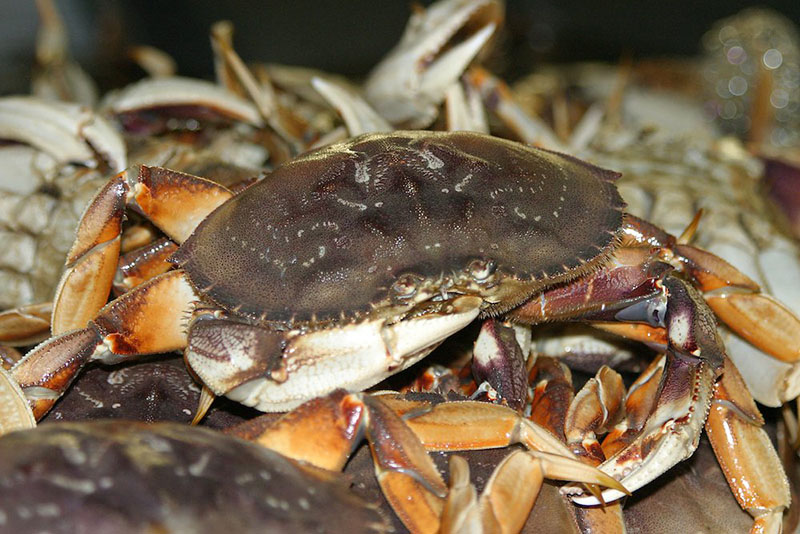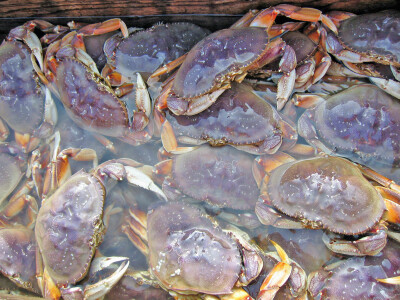A healthy Dungeness crab season and a big year for California salmon trollers made for a successful 2019 for many West Coast fishermen.
Petrale sole even saw the beginnings of what looks to be a comeback that could land it on restaurant menus regularly again. But the San Francisco herring fleet did not see its hopes for a stronger market and increasing biomass materialize.
WINNERS
Dungeness: The long, bountiful ride continued for West Coast Dungeness crabbers, with 19 million pounds landed in 2019. Ex-vessel prices were nothing to sneeze at either. According to preliminary data from PacFIN, the Oregon fleet averaged $3.58 per pound for revenues of $66.7 million. Though the season opened very late on Feb. 1, it went off without strikes or major holdups in state-sanctioned price negotiations. Better yet the meat fill was heavy. Ex-vessel offers for some shipments of live crab shipped to Asia can hit around $5 per pound. Industry estimates hold that about 35 to 40 percent of Oregon Dungies wind up in Asia, where they were subject to trade tariffs.
Salmon: Winter rain and snow, healthy ex-vessel prices and an official declaration that El Niño has ended added up for a banner year of salmon production in California. According to PacFIN, the California troll fleet landed 2.95 million pounds in 2019. At average ex-vessel prices of $5.55 per pound, revenues for the fleet crunch out to $16.39 million.
That more than doubles landings of 1.07 million pounds in 2018 but falls short of the record harvest year of 2013. The surplus freshwater runoff made its way to the spawning beds of the Sacramento and other salmon-rearing rivers, and droves of salmon fry made their way to sea. At the same time, ocean temperatures have returned to normal, according to climatologists with NOAA, which meant optimum survival conditions for this year’s age class. Better yet, continued rainfall and ocean temperatures bode well for 2020.
Petrale sole: Trawlers found dense concentrations of petrale sole and landed 1,708 metric tons of a 2,587-metric-ton quota. Ex-vessel prices averaged $1.19 per pound, putting the season’s revenues at $4.48 million. Various biomass surveys bode well for substantial increases in the quotas for the 2020-21 and 2021-22 seasons.
Shrimp: As ocean temperatures hit the nexus between La Niña and El Niño, survival rate among young shrimp recruiting into the fishery — and rapid growth during the season afforded Oregon a good year. In the end, the fleet put up 26.9 million pounds. At the average ex-vessel price of 74 cents a pound, fleet revenues crunched out to nearly $20 million.
LOSERS
Herring: The San Francisco herring industry held hopes for increasing biomass and stronger market demand in the advent of the 2019 season. The gillnet harvest quota had been set at 775.6 short tons, and the harvest came in at 718 short tons, according to data from PacFIN. Though PacFIN data notes an average ex-vessel price of $500 per ton, some deliveries brought considerably less, based on low roe content. Though previous biomass estimates showed a healthy component in fish ranging from 5 to 9 years old, the industry worried that the lack of 2- and 3-year-old fish present in surveys and in the fishery could spell a further reduction in spawning biomass.
Urchins: Purple urchins continue to plague divers seeking out red urchins throughout California. The Blob, El Niño and other environmental factors stacked up a few years ago, decimating large beds of giant and bull kelp. Warmer waters led to the disappearance of the sea star, a key predator that kept populations of purple urchins in check. “Urchin barrens,” as they are known, have attracted supporters for purple urchin eradication in the form of grants. Last year, divers cleaned several areas and had the purple urchins ground into meal,. The hope is that similar efforts in the future will sterile the ground and allow the more profitable red urchins to return in abundance.
Blackcod: Though the biomass of blackcod increased slightly, recruitment of young age classes into the fishery has thrown the predominance of the catch toward 1- to 2-pound fish. Several years ago, pricing splits began at their bottom end with around $3 per pound for 3- to 4-pound fish and ratcheted their way through the weight brackets with more than $8 per pound for fish 7 pounds and up. In the last several years, however, mainstay markets in Japan have adapted to moving smaller fish through the chain to consumers — but at a reduced price point. The combination of smaller fish and lower prices translates to abysmally low value at the end of each baited hook: A 2-pound fish last year brought $3.60, while an 8-pounder just two years ago sold for $64.
ONES TO WATCH
Squid: Squid fishing got off to a slow start for West Coast seiners, but early catches in the cooler waters offshore of Oregon had the fleet hopeful that biomass would show up farther south as the summer ensued. Like shrimp and other species, the industry bet that cooling waters would restore the population back to health. According to data with PacFIN, seiners in the three states landed 23,612 tons for 2019, far short of the 118,000-ton max cap imposed by harvest regulations. As for more recent revenues, the 2019 squid crop came in at $11.91 million in revenues, which pegs ex-vessel prices at just under $1,000 per ton.
Swordfish: According to a recent stock assessment report to the International Scientific Committee for Tuna and Tuna-Like Species in the North Pacific Ocean, in 2018, swordfish biomass has increased from 51,000 metric tons in 1998 to an estimated 71,979 metric tons in 2016. The U.S. fleet working the waters in the Western and North Central Pacific Ocean harvested 157.7 metric tons in 2019. At average ex-vessel prices of $4.31 per pound the fishery tallied up to revenues of around $1.5 million. West Coast landings are but a fraction of what the fleet from Japan catches in a year.
Spiny Lobster: California’s spiny lobster production for the 2018-19 season should come in on par with the 2017-18 season. At the end of the year, divers landed 442 metric tons and received average ex-vessel offers of $14.46 per pound for revenues of $14.09 million, according to data from PacFIN.







